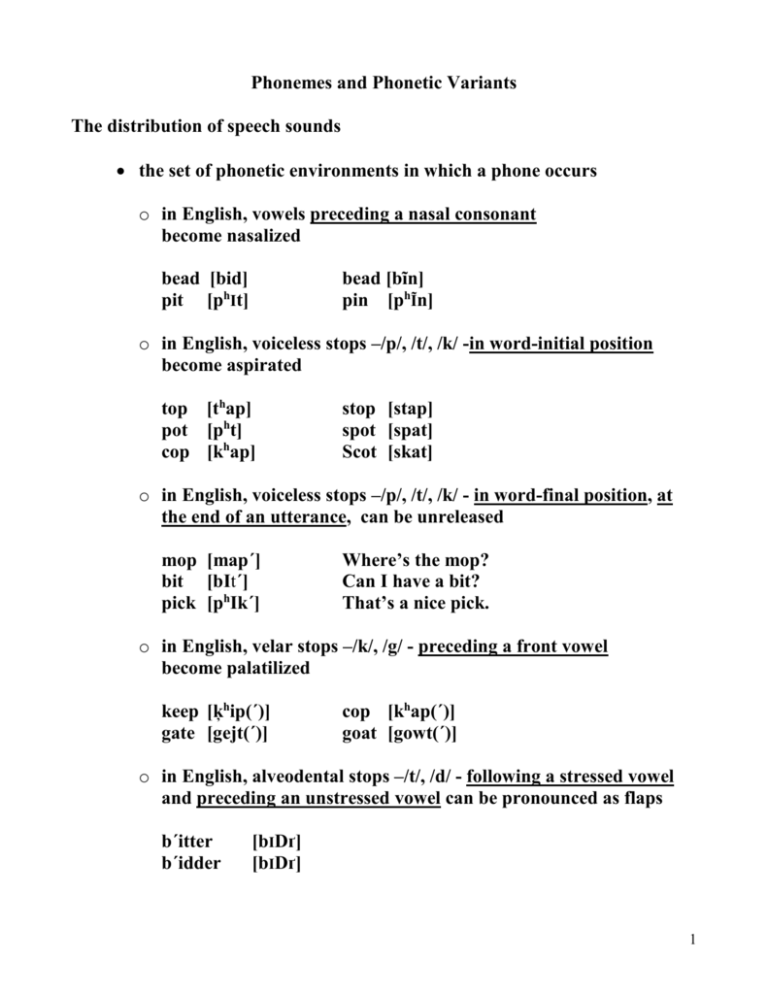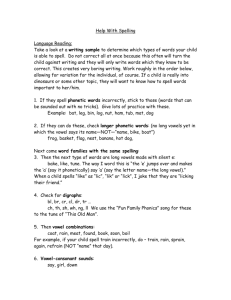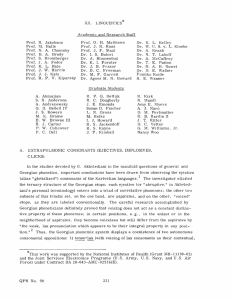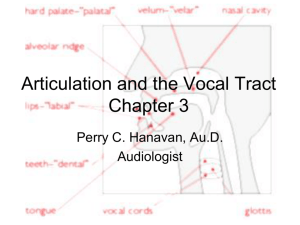The distribution of speech sounds
advertisement

Phonemes and Phonetic Variants The distribution of speech sounds the set of phonetic environments in which a phone occurs o in English, vowels preceding a nasal consonant become nasalized bead [bĩn] pin [phĨn] bead [bid] pit [phIt] o in English, voiceless stops –/p/, /t/, /k/ -in word-initial position become aspirated top [thap] pot [pht] cop [khap] stop [stap] spot [spat] Scot [skat] o in English, voiceless stops –/p/, /t/, /k/ - in word-final position, at the end of an utterance, can be unreleased mop [map΄] bit [bIt΄] pick [phIk΄] Where’s the mop? Can I have a bit? That’s a nice pick. o in English, velar stops –/k/, /g/ - preceding a front vowel become palatilized keep [ķhip(΄)] gate [gejt(΄)] cop [khap(΄)] goat [gowt(΄)] o in English, alveodental stops –/t/, /d/ - following a stressed vowel and preceding an unstressed vowel can be pronounced as flaps b΄itter b΄idder [bIDґ] [bIDґ] 1 1. Contrastive distribution a pair of phones is contrastive if interchanging the two, results in a new word o the sounds occur in the same environment, and o contrast meanings - make different words o they are different phonemes in English: /p/ vs. /b/ pat vs. bat /p/ with its phonetic variants [ph], [p], [p(΄)] is a distinct phoneme in Hindi: /ph/ vs. /p/ [phәl] ‘fruit’ vs. [pәl] ‘moment’ /p/ and /ph/are distinct phonemes in English: /l/ vs. /r/ leaf vs. reef /l/ and /r/ are distinct phonemes 2. Complementary distribution two sounds in complementary distribution are in mutually exclusive distribution the sounds always appear in different phonetic environments phones in complementary distribution are allophones of the same phoneme o in English: /p/ [ph] aspirated in word-initial position [p] unaspirated when following /s/ 2 /k/ [ķh] palatalized in word-initial position before a front vowel kit [kh] aspirated in word-initial position preceding other vowels cop [ķ] palatalized preceding front vowels skip [k] in other environments Scot /i/ [ĩ] nasalized before a nasal consonant pin [i] oral (non-nazal) in all other environments pit o in Korean: [l] vs. [r] [r] occurs between vowel [l] never occurs between vowels 3. Free variation variants of a phoneme that can replace one another in exactly the same environment are called free variants there is a tremendous amount of free variation in speech which goes entirely unnoticed o in English: the alternation between word-final released and non-released stops is an example of free variation word-final stops can be optionally non-released at the end of an utterance [p(΄)] - [map(΄)] 3











